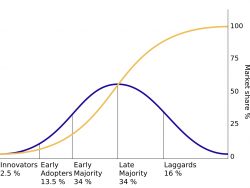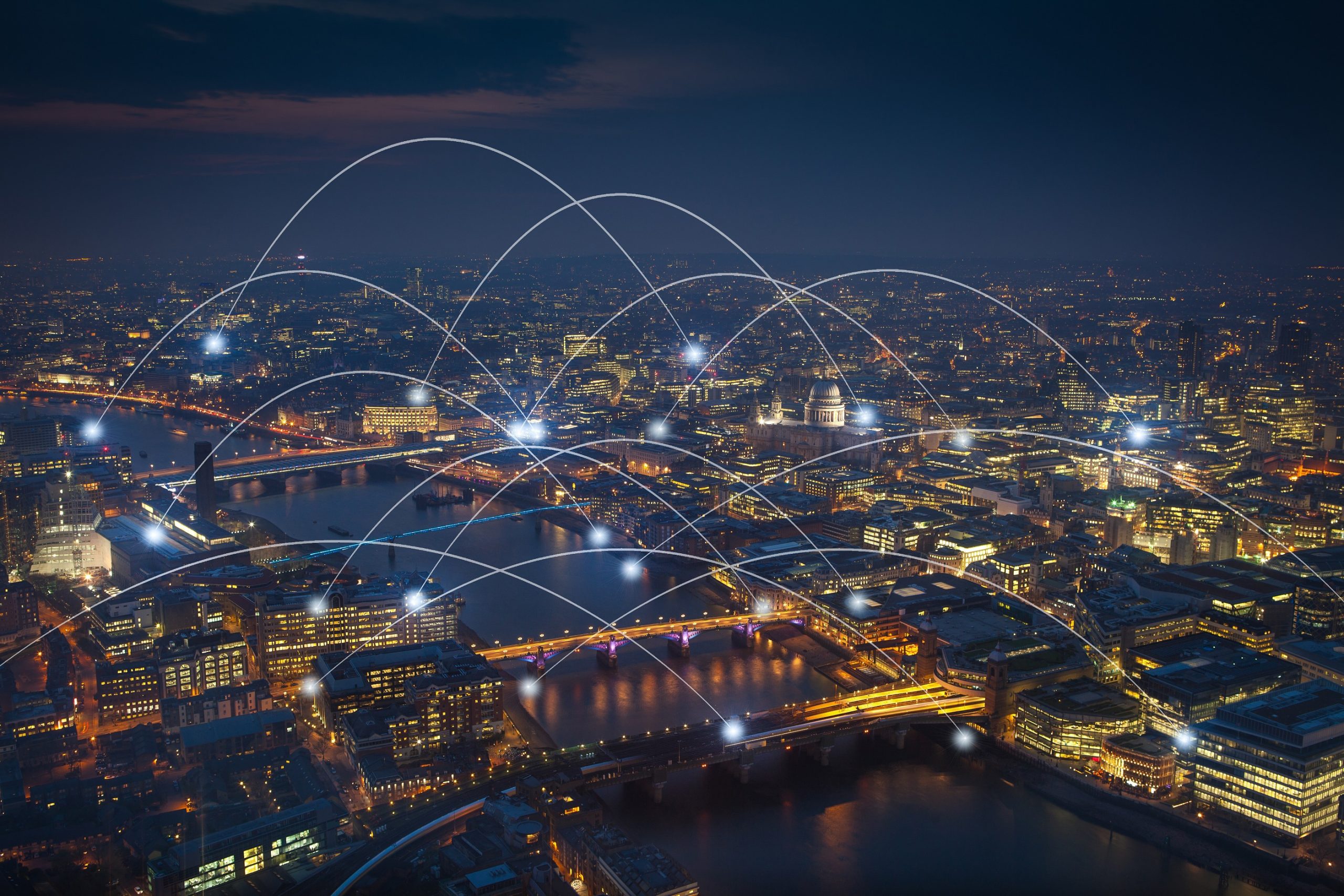In 2010, the five-year-old Tesla Motors had been manufacturing cars—to be precise, one car, the $130,000 luxury Roadster—for only two years. They had sold a grand total of 1,500 of them. Automobile industry insiders scoffed at the idea of electric cars being adequate, let alone superior to internal combustion cars, and ridiculed the company’s plans for autonomous control.
Ten years later, Tesla’s market capitalization exceeds that of the next ten auto manufacturers in the world combined. Their number of units sold made them not only the leading producer of electric vehicles, but the Model 3 was the best-selling car of any kind in California in the first quarter of 2020.
This is what it means to live in a world of technological disruption. When Hemingway’s character Mike Campbell says in The Sun Also Rises that he went bankrupt “Two ways: gradually, then suddenly,” he was also describing how today’s disruption creeps up imperceptibly, yet then becomes overwhelming. Less than two years ago, Tesla was almost bankrupt and widely dismissed.
Are your business coaching clients positioned to be the equivalent of the next Tesla, or of the now-tottering competitors left in their dust? Every industry has the potential to be similarly upended; there are at least ten Tesla-like companies disrupting other sectors to similar extents. COVID-19 gave all of us a taste of what exogenous disruption feels like, but the slower yet inexorable disruption from technology, in particular, artificial intelligence, will exert a far greater impact. As AI grows exponentially—deep learning models are doubling in size on average every three months now—our ability to keep up will be so limited in comparison as to make wide scale disruption the new normal. Imagine the equivalent of COVID every year!
Coaching an individual to not only cope but thrive on disruption is a world-view-changing journey that can rebuild the very foundations of their career identity. Just as Navy Seals are trained for six months to face unpredictable threats, helping someone adjust to the rug being pulled out from under their business can be a life-altering transformation.
The International Coaching Federation (ICF) defines coaching as partnering in a thought-provoking and creative process that inspires a person to maximize their personal and professional potential. The process of coaching often unlocks previously untapped sources of imagination, productivity and leadership. When you work with a professional coach, you set out on a path to greater personal and professional fulfillment.
Coaching for the future
Futureproofing is the process of becoming resilient against disruption, and we address it in the business as well as the individual, because each has different needs that shape the ecosystem they both reside in. We apply the CHANGE process to businesses:
- Comprehend disruption: Learn what complexity, chaos, and exponential progress means for their world, their sector, and their company;
- Hire change agents: Whether from within or without, identify individuals who can act as champions of change;
- Antifragility (a term from Nassim Nicholas Taleb) checkup: Assess their ability to gain strength from disorder;
- New vision: How does the vision and the mission of the company need to change to be antifragile;
- Generate KPIs based on velocity, not position: Too many indicators of performance are static. Think about a balance sheet: it is a snapshot that says nothing about movement. Retool reports to indicate rates of change;
- Everything is on the table: To succeed, a business must be willing to reconsider everything, starting with its very identity.
When we consulted to a boutique Southern California bank, their executives expressed a goal of acquiring younger clients. Through the CHANGE model they realized that their customer representatives were almost all outside the age range of the clients they wished to attract. This realization led to greater awareness of hidden assumptions that shaped important decisions.
When coaching an individual to become more resilient and innovative within a business undergoing CHANGE, we apply the RIPPLE process to identify areas to address:
- Reveal fears: People are apprehensive of the unknown, and fearful of becoming irrelevant or unable to cope. Lay these bare and examine which are real. They may have what Martin Seligman termed learned helplessness, robbing them of the ability to respond to challenges;
- Identity: People can associate their very selves with a role or activity (“I’m a ____; that’s just who I am”). Help them find a deeper identity than what they do. The Leadership Circle[1] can be used to help a client evolve from a reactive to a creative identity;
- Purpose: Recreate their individual purpose and connect it to the enterprise mission;
- Prejudice or bias: Do they have biases, like confirmation bias, that blind them to disruption and opportunity/innovation? 360° assessments can aid in identifying some blind spots;
- Learning: Assist them in moving from fixed mindsets to growth mindsets. How can they move to more proactive levels of the Diffusion of Innovation Curve? The Toyota kata[2] can be used to facilitate that movement through cycles of continuous evolution;
- Evolve situational awareness. Disruption demands our constant attention and reassessment. The VUCA and Cynefin models assist with this (see sidebars).
- It is important to realize that even when the future of an individual’s job is optimistic, when the application of AI promises revolutionary change to more effective and fulfilling work, that change of any kind on such a scale can terrify them. Fear of becoming irrelevant or being laid off is a common place to start RIPPLE.
- Neuro-linguistic programming timeline techniques are useful throughout this process, in particular, future pacing—asking the client to place themselves in the (initially scary unknown) future, identify and address the concerns; then after coaching, revisit the future in their more empowered identity.
Ready or not, here comes the future
Preparing for disruption is no longer an option for members of businesses that want to survive. As a coach, you are probably familiar with Maslow’s Hierarchy of Needs, a pyramid model asserting that physical needs (food, etc) must be met before an individual can grow in their emotional, social, etc, expression, culminating in self-actualization: reinventing themselves. We assert that in the face of disruption, the pyramid is inverted for organizations: that the very survival of the enterprise depends upon its principals driving transcendence, of themselves and the business.
Not every business will disrupt the world with a meteoric passage like that of Tesla Motors; but all businesses, like it or not, now live in an ecosystem shaped by dramatic disruption. Just as companies must learn that their survival may now depend upon their people achieving the self-examination and transformation that coaching can deliver, coaches need to understand the dynamics of the technological forces that are transfiguring our world. The future calls all of us to become our best selves.
The Diffusion of Innovation Curve
Everett Rogers showed how a few early adopters respond to new development at first, then increasing numbers join the bandwagon at increasing rates until the curve levels off as the remaining laggards join in.

DIAGRAM taken from Wikipedia at https://en.wikipedia.org/wiki/Diffusion_of_innovations (public domain)
VUCA
The U.S. Army War College developed the VUCA model for interpreting a world whose threats changed drastically following the Cold War. In the context of a business environment, the stages and questions for an executive within them are:
- Volatility: Existing dynamics change more radically than before. How can they stockpile resources and act more rapidly?
- Uncertainty: Changes in ways that have unpredictable consequences. How can they gather more information to reduce uncertainty?
- Complexity: Changes in so many ways that it is overwhelming to try to understand it. How can they build up resources that can see the big picture?
- Ambiguity: Changes in ways that create confusion. How can they test and measure their new world?
Cynefin
The Cynefin framework (from the Welsh word for habitat) developed by Dave Snowden at IBM Global Services describes five domains that any individual or business may find themselves encountering. Learning to recognize and respond appropriately to each domain helps them make better decisions.
- Clear: “Known knowns.” The situation is stable and established practices are the best response.
- Complicated: “Known unknowns.” The environment is difficult to analyze and negotiate, requiring expert knowledge.
- Complex: “Unknown unknowns.” Cause and effect are impenetrable; there are no right answers.
- Chaotic: Cause and effect are unclear, and crisis abounds. Strong leadership is required to create order and action.
- Confused: There is no clarity as to which domain applies. Leaders need to decompose the situation into parts that can be addressed within the individual domains.
Cynefin is used primarily to consider the dynamics of situations, decisions, perspectives, conflicts, and changes in order to come to a consensus for decision-making under uncertainty.
Pierre Dussault Eng is a Professional Certified Coach (PCC) and leadership/management consultant.nextwaveinstitute.org







